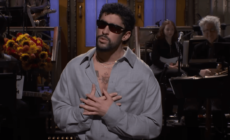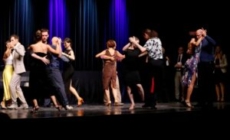Over the past two decades, Argentine tango has taken root in Hungary, evolving from a niche interest to a dynamic and inclusive subculture. Today, tango is more than a dance—it is a growing cultural bridge connecting Hungarians with the wider international community, and most notably, with Argentina, the birthplace of the art form.
This September, the 5th International Tango Festival of Pécs offered a compelling snapshot of how deeply tango has integrated into Hungary’s cultural fabric. Held in the Zsolnay Cultural Quarter and other iconic sites throughout the southern city, the three-day festival drew participants from across Europe and highlighted tango’s rich musical, historical, and social dimensions.
Couples dancing at the amateur tango competition during the 5th International Tango Festival of Pécs. Photo: Facebook/Péterffy Attila
Among its standout events was a series of milongas—tango’s traditional social dance evenings—set against the backdrop of the Zsolnay Cultural Quarter, blending the evocative atmosphere of ancient architecture with the intimate rhythm of tango. The program also included live music, film screenings, a dance competition for amateur couples, and beginner-friendly workshops, making it accessible to both seasoned dancers and newcomers. The event was also honored by the presence of H.E. Ms. María Lorena Capra, Ambassador of Argentina to Hungary.

Follower dancers often close their eyes during dancing Tango in order to pay full attention to the leader. Photo: Méhes Károly
While Pécs has emerged as a southern stronghold, Budapest remains the epicenter of Hungary’s tango culture. The capital is home to more than a dozen active tango schools, clubs, and studios, including Tango Libre, Budai Tango Club, Hello Tango, and Tango Factory Budapest.

Dancers at the amateur Tango competition in Pécs during the Tango Festival. Photo: Tóth László
These institutions offer weekly classes, milongas, and workshops ranging from traditional tango de salón to more contemporary interpretations. Many schools have embraced bilingual instruction (Hungarian and English), welcoming an increasingly international base of dancers, including students, expatriates, and tourists.

Dancers at the evening Tango Ball milonga in Pécs during the Tango Festival. Photo: Hungary Today
Community-building is a core feature. Many events are designed to be inclusive and accessible, with no partner required, a low barrier to entry, and a welcoming atmosphere for dancers of all ages and backgrounds.

Dancers at the evening Tango Ball milonga in Pécs during the Tango Festival. Photo: Hungary Today
In April 2025, Budapest further cemented its reputation on the international tango map by hosting a Preliminary Round of the Buenos Aires Tango World Championship, an event sanctioned by the Argentine Ministry of Culture. This marked the first time Hungary hosted a qualifying round for the world’s most prestigious tango competition.

Dancers in the embrace -the very essence of Tango – at the amateur Tango competition in Pécs during the Tango Festival. Photo: Tóth László
The event, co-organized with the Embassy of Argentina, showcased not only Hungary’s top tango talent, but also the country’s growing cultural ties with Latin America. Diplomats, artists, and dancers shared the stage in a rare blend of art and international cultural diplomacy.

Dancers at the amateur Tango competition in Pécs during the Tango Festival. Photo: Méhes Károly
Hungary now hosts at least four annual tango festivals, each with a distinct identity. The El Sabor de Hungría Festival in Budapest, the Komárom Tango Minifestival, and the Pécs Tango Festival are among the most prominent. These gatherings serve as cross-cultural hubs, facilitating knowledge exchange, artistic collaboration, and international friendship.

Performance of “Existence” stage tango show of Buday Tango Club. Photo: Hungary Today
The festivals blend traditional milongas with contemporary tango culture, including DJ-led dance nights, live orchestras, and interdisciplinary elements like tango film screenings and lectures on tango’s social history.
Despite its growth, the tango scene in Hungary faces several challenges. Venue limitations, seasonal weather (especially for outdoor events), and funding constraints can impact programming and accessibility. Still, the scene has shown remarkable resilience and adaptability.

Dancers at the amateur Tango competition in Pécs, receiving their bronze trophy during the Tango Festival. Photo: Tóth László
With the support of private sponsors, public cultural institutions, and a passionate volunteer base, tango continues to flourish in unexpected ways—including outdoor summer milongas at Buda Castle, pop-up classes in city parks, and tango-themed film nights at arthouse cinemas.

Performers of stage Tango show “Existence” in Pécs, during the Tango Festival. Photo: Hungary Today
As tango continues to grow in Hungary, it represents more than artistic expression—it reflects a broader movement toward global cultural exchange, community building, and intergenerational connection. In a country with a strong tradition of music and movement, tango is finding not just space, but resonance.
With each new festival, workshop, and milonga, Hungary steps further into a global conversation—one expressed not in words, but in the quiet dialogue of the dance.
Fact
Tango was declared a UNESCO Intangible Cultural Heritage in 2009, helping raise global awareness of its cultural value. Hungary now hosts over 120 active tango events annually, including weekly milongas and international festivals, and more than 15 schools and clubs operate across the country.
Related article
Tango Takes Over Pécs: Three Days of Passion, Rhythm, and Dance

From fiery dance battles, to romantic milongas and live concerts, the 5th Pécs International Tango Festival brings the spirit of Buenos Aires to Hungary’s cultural capital.Continue reading
Featured image: Facebook/Zag Gábor
The post In Step with Buenos Aires: We Are Embracing the Spirit of Argentine Tango appeared first on Hungary Today.
Source link







































